Conditions of the Iris : The iris is more than just the colored part of your eye that gives you your unique eye color. This remarkable structure plays a crucial role in your vision by controlling how much light enters your eye. When conditions affect the iris, they can impact both your eye’s appearance and function. Understanding these conditions is essential for maintaining optimal eye health and seeking appropriate treatment when needed.
Anatomy and Function of the Iris
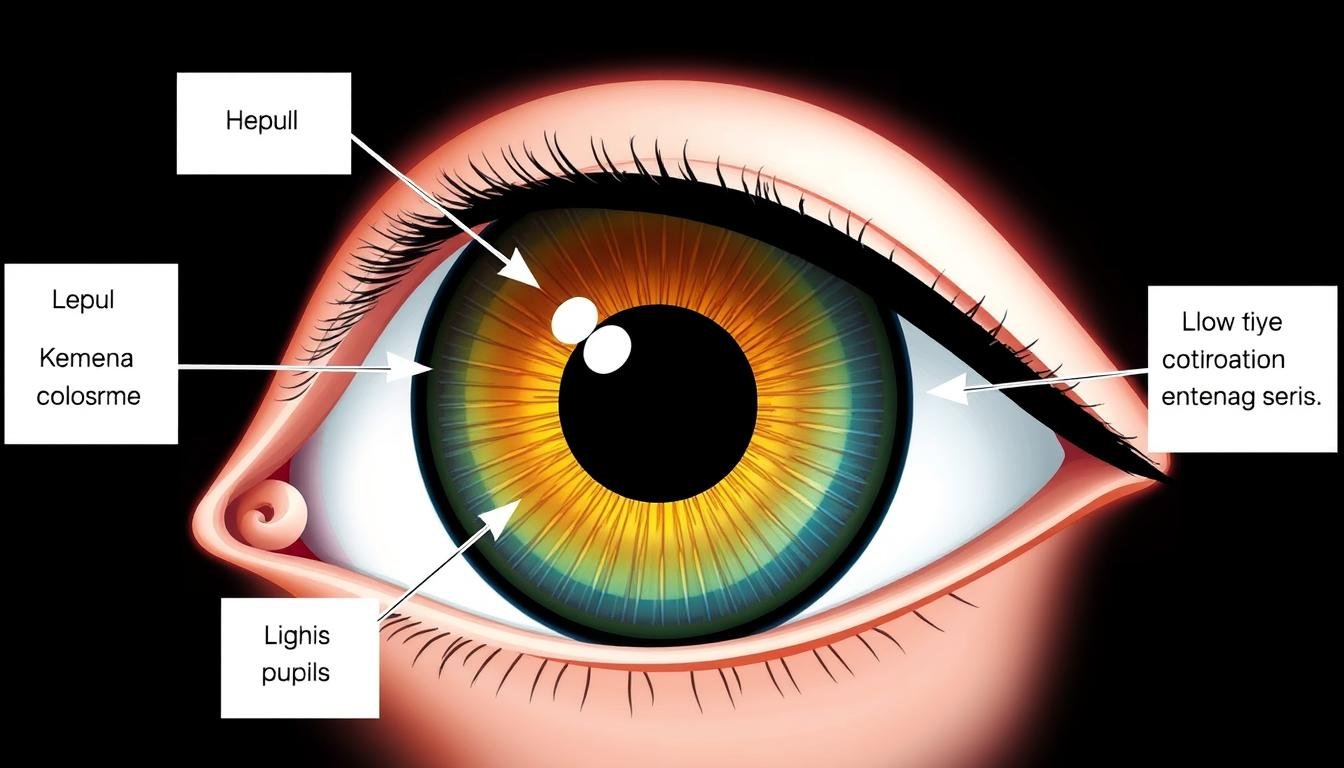
The iris controls how much light enters your eye by adjusting pupil size
Conditions of the Iris:The iris is a flat, colored, ring-shaped membrane behind the cornea of the eye. It surrounds the pupil, which is the black circular opening that allows light to enter the eye. Made up of muscles and nerves, the iris works automatically to control the size of your pupil in response to light conditions.
When you step into bright sunlight, the muscles in your iris contract the pupil to reduce the amount of light entering your eye. In dim lighting, these same muscles relax, allowing your pupil to dilate and let in more light. This constant adjustment helps maintain optimal vision across varying light conditions.
Ten iris has two zones: the pupillary zone (inner region near the pupil) and the ciliary zone (the larger outer region). The color of your iris is determined by the amount of melanin present and is as unique as your fingerprint.
Common Conditions of the Iris
Several conditions can affect the iris, ranging from inflammatory disorders to structural abnormalities. Understanding these conditions is the first step toward proper diagnosis and treatment.
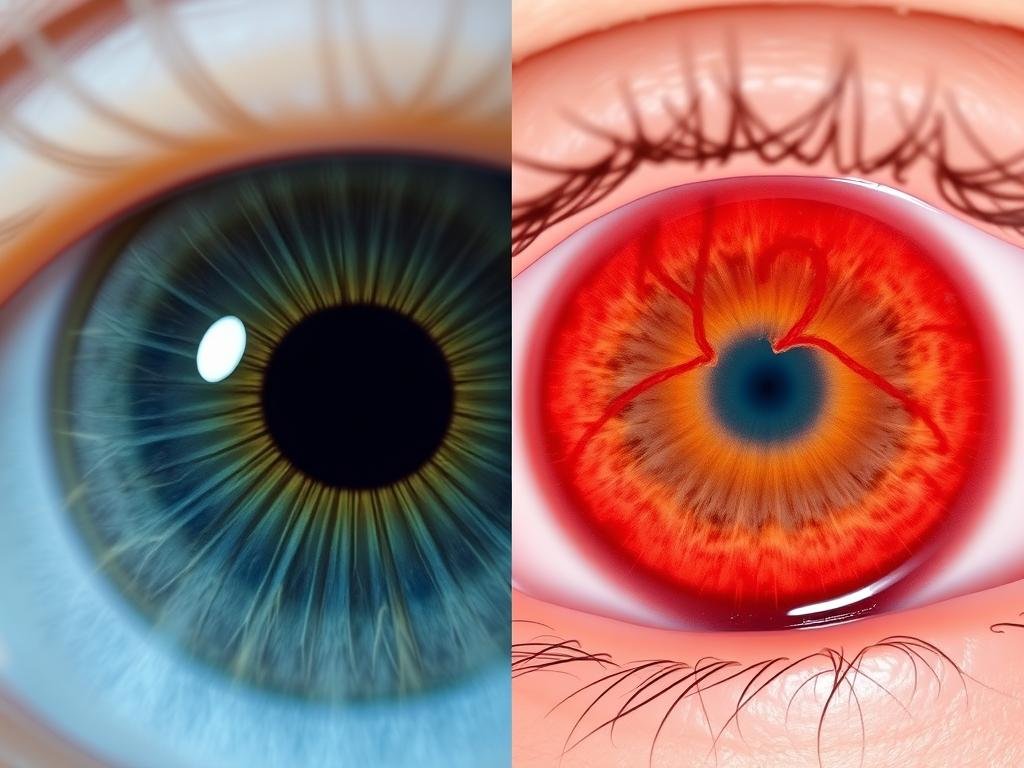
Comparison between a healthy iris (left) and an iris with iritis (right)
IRORS (predchádzajúca uveitída)
Iritis, also known as anterior uveitis, is inflammation of the iris and the adjacent ciliary body. This condition can cause pain, redness, light sensitivity, and blurred vision. Iritis may develop suddenly (acute) or gradually (chronic) and can be associated with autoimmune disorders, infections, or trauma.
Predamerica
Conditions of the Iris:Aniridia is a rare genetic condition characterized by the partial or complete absence of the iris. People with aniridia often experience light sensitivity, poor vision, and may develop other eye problems such as glaucoma and cataracts. This condition is typically present at birth.
Coloboma
Conditions of the Iris:An iris coloboma is a gap or notch in the iris that occurs when the eye doesn’t develop properly before birth. It appears as a keyhole-shaped pupil and can cause increased light sensitivity and vision problems, depending on its severity.
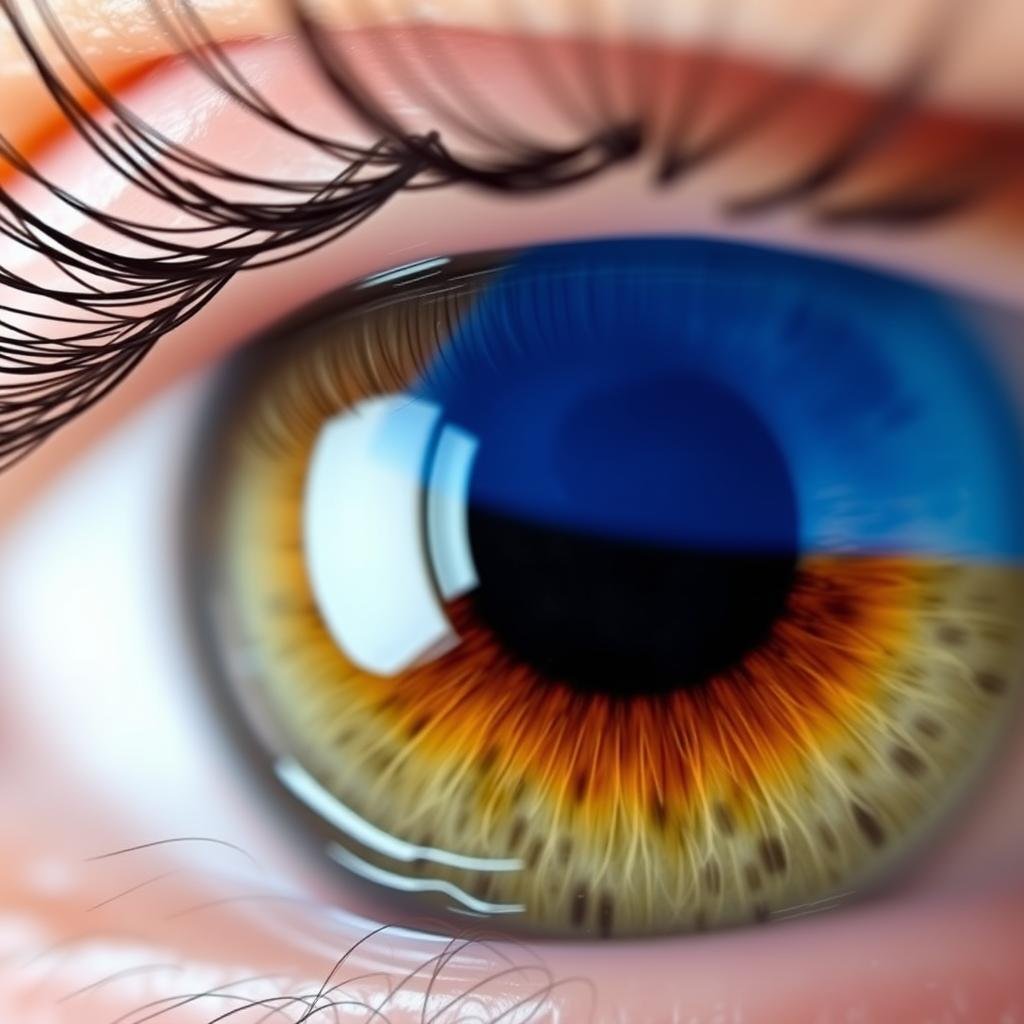
Heterochromia – different colored sections within the same iris
Heterochromia
Heterochromia is a condition where a person has different colored irises or different colors within the same iris. While often harmless and present from birth, heterochromia that develops later in life may indicate an underlying condition such as Horner’s syndrome or inflammation.
Iris Melanoma
Iris melanoma is a rare form of cancer that develops from the pigmented cells of the iris. It may appear as a dark spot on the iris that grows over time. While many iris melanomas grow slowly, they can potentially spread to other parts of the body if left untreated.
Pigment Dispersion Syndrome
In this condition, pigment from the back of the iris flakes off and floats around in the eye. These pigment granules can clog the drainage system of the eye, potentially leading to pigmentary glaucoma and increased eye pressure.
Zaujíma vás o vaše zdravie očí?
If you’re experiencing any changes in your vision or eye appearance, don’t wait for symptoms to worsen. Early diagnosis and treatment are crucial for preserving your vision.
Schedule an Eye Exam
Symptoms of Iris Conditions
Recognizing the symptoms of iris conditions is essential for seeking timely medical attention. While symptoms vary depending on the specific condition, there are several common signs to watch for:

Light sensitivity (photophobia) is a common symptom of many iris conditions
Visual Symptoms
- Rozmazané alebo znížené videnie
- Citlivosť na svetlo (fotofóbia)
- Seeing halos around lights
- Difficulty focusing
- Vision loss (in severe cases)
Fyzické príznaky
- Eye pain or discomfort
- Redness in the eye
- Nepravidelný tvar žiaka
- Changes in iris color or appearance
- Tearing or watery eyes
POZOR: Seek immediate medical attention if you experience sudden vision changes, severe eye pain, or if your pupil appears irregular. These could be signs of a serious eye condition requiring prompt treatment.
Causes of Iris Conditions
Iris conditions can stem from various causes, including genetic factors, trauma, infections, and systemic diseases. Understanding these causes can help with prevention and early intervention.
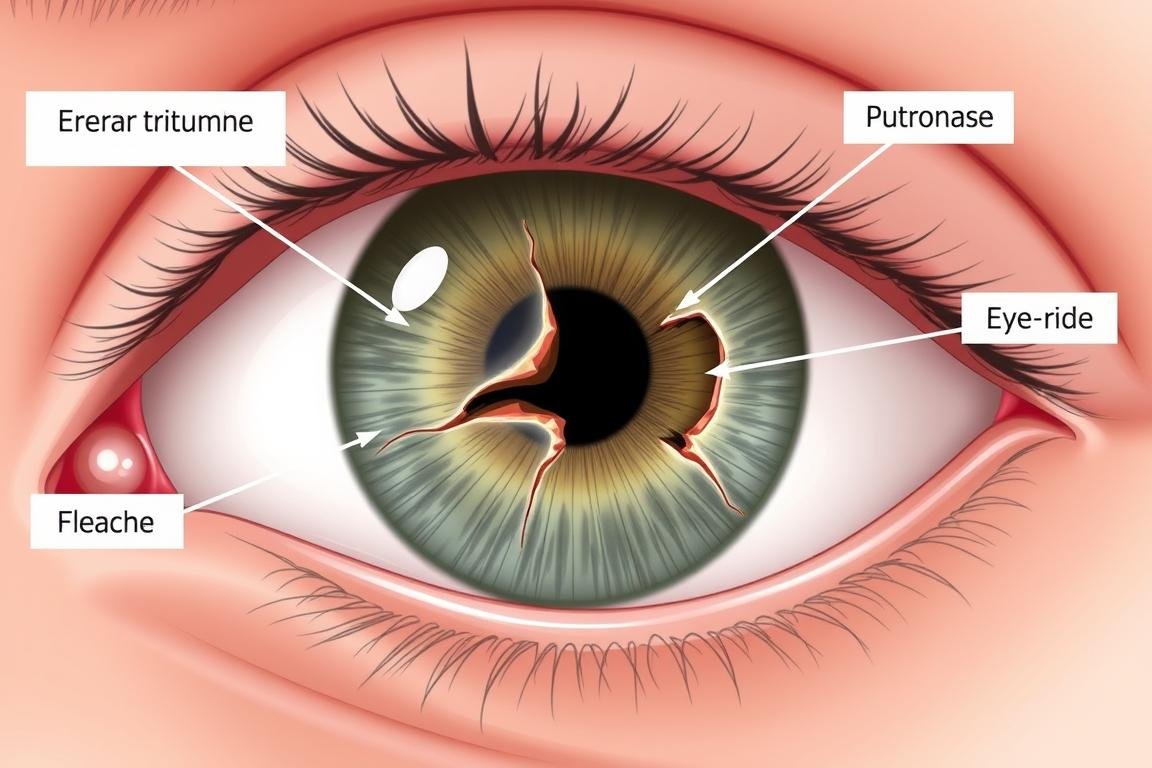
Eye trauma can cause structural damage to the iris
Genetické faktory
Some iris conditions, such as aniridia and certain forms of heterochromia, are inherited or result from genetic mutations. These conditions are typically present at birth or develop early in life. Genetic testing may be recommended for patients with family histories of these conditions.
Trauma
Eye injuries can damage the iris, leading to tears, inflammation, or changes in pupil shape. Blunt force trauma, penetrating injuries, and surgical complications can all cause iris damage. Wearing protective eyewear during high-risk activities can help prevent these injuries.
Infections
Various infections can lead to inflammation of the iris. These include viral infections (like herpes), bacterial infections, fungal infections, and parasitic infections. Prompt treatment of eye infections is essential to prevent complications.
Autoimmune Disorders
Several autoimmune conditions can affect the iris, including rheumatoid arthritis, ankylosing spondylitis, inflammatory bowel disease, and juvenile idiopathic arthritis. In these conditions, the body’s immune system mistakenly attacks its own tissues, including those in the eye.
Systemic Diseases
Certain systemic diseases can have ocular manifestations that affect the iris. These include diabetes, hypertension, and various inflammatory disorders. Managing these underlying conditions is often an important part of treating the associated iris problems.
Diagnosing Iris Conditions
Accurate diagnosis of iris conditions requires a comprehensive eye examination by a qualified eye care professional. Several diagnostic methods may be employed to evaluate the health and function of your iris.

Slit-lamp examination is essential for diagnosing many iris conditions
Comprehensive Eye Examination
A thorough eye exam is the first step in diagnosing iris conditions. This includes visual acuity testing, pupil evaluation, and examination of the external and internal structures of the eye.
Slit-Lamp Examination
This specialized microscope allows the eye care professional to examine the iris in detail. The slit-lamp provides a magnified, three-dimensional view of the eye’s structures, making it easier to detect abnormalities in the iris.
Optical Coherence Tomography (OCT)
OCT is a non-invasive imaging test that uses light waves to take cross-section pictures of the eye’s structures, including the iris. This technology can help detect subtle changes in iris thickness and structure.
Ultrasound Biomicroscopy
This specialized ultrasound technique provides detailed images of the anterior segment of the eye, including the iris. It’s particularly useful for evaluating iris tumors and cysts.
Additional Diagnostic Tests
Depending on the suspected condition, your doctor may recommend additional tests such as:
- Tonometry to measure intraocular pressure
- Gonioscopy to examine the drainage angle of the eye
- Fluorescein angiography to evaluate blood vessels
- MRI or CT scans for more complex cases
- Blood tests to check for underlying systemic conditions
Expert Diagnosis Makes All the Difference
Many iris conditions require specialized diagnostic equipment and expertise. Don’t leave your eye health to chance.
Find a Specialist Near You
Treatment Options for Iris Conditions
Treatment approaches for iris conditions vary widely depending on the specific diagnosis, severity, and underlying causes. Many conditions require professional medical intervention to prevent complications and preserve vision.
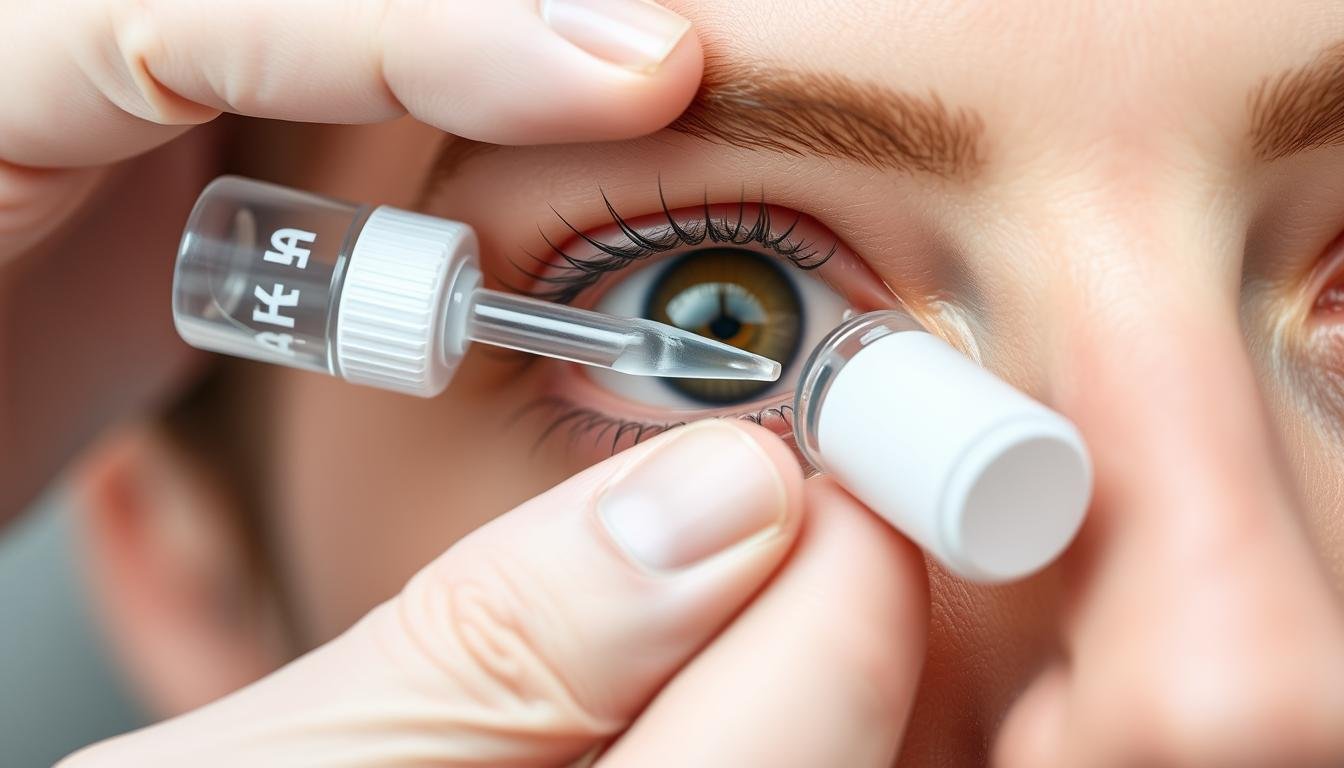
Medicated eye drops are a common treatment for many inflammatory iris conditions
Medications
Various medications may be prescribed to treat iris conditions, including:
- Anti-inflammatory drugs: Corticosteroid eye drops, oral steroids, or non-steroidal anti-inflammatory drugs (NSAIDs) to reduce inflammation in conditions like iritis
- Antibiotics: To treat bacterial infections that may affect the iris
- Antiviral medications: For viral causes of iris inflammation
- Immunosuppressive drugs: For severe cases of autoimmune-related iris conditions
- Pressure-lowering medications: To manage increased intraocular pressure associated with some iris conditions
Surgical Interventions
Surgery may be necessary for certain iris conditions, particularly those involving structural abnormalities or tumors:
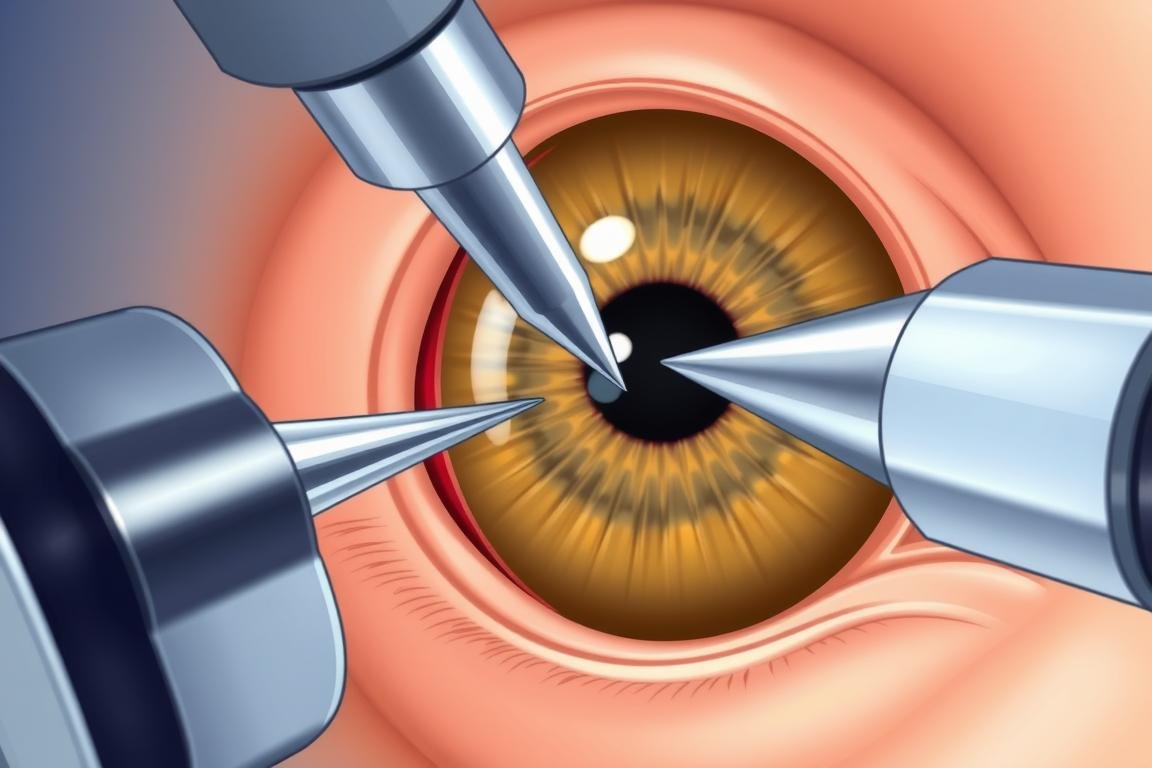
Microsurgical techniques allow for precise repair of iris damage
- Iris repair: For tears or trauma to the iris
- Iridectomy: Removal of a portion of the iris, often to treat narrow-angle glaucoma
- Artificial iris implant: For patients with significant iris damage or aniridia
- Tumor removal: Surgical excision of iris melanomas or other growths
- Laser procedures: To create small openings in the iris or treat other specific conditions
Management of Underlying Conditions
When iris conditions are secondary to systemic diseases, treating the underlying condition is essential. This may involve:
- Management of autoimmune disorders with appropriate medications
- Blood sugar control for diabetes-related eye complications
- Treatment of hypertension to prevent further eye damage
- Addressing inflammatory conditions that affect multiple body systems
Supportive Care
Additional measures may help manage symptoms and improve quality of life:
- Photochromic lenses or sunglasses for light sensitivity
- Visual aids for those with permanent vision impairment
- Cosmetic contact lenses for aesthetic concerns related to iris abnormalities
- Pain management strategies for conditions causing discomfort
Prevention and Eye Care
While not all iris conditions can be prevented, certain measures can help maintain overall eye health and reduce the risk of complications.

Protective eyewear can prevent traumatic iris injuries during high-risk activities
Protective Measures
- Wear protective eyewear during sports, home improvement projects, and other activities that pose a risk of eye injury
- Use UV-protective sunglasses when outdoors to shield your eyes from harmful rays
- Follow proper contact lens hygiene to prevent infections that could affect the iris
- Take precautions in environments with potential eye hazards (chemicals, dust, debris)
Regular Eye Examinations
Routine eye exams are crucial for early detection and management of iris conditions. The American Academy of Ophthalmology recommends:
- Comprehensive eye exams every 1-2 years for adults
- More frequent exams for those with risk factors or existing eye conditions
- Prompt evaluation when experiencing any new eye symptoms
- Regular monitoring for patients with chronic iris conditions
Lifestyle Considerations
Certain lifestyle choices can support overall eye health:
- Maintain a balanced diet rich in antioxidants, omega-3 fatty acids, and vitamins A, C, and E
- Stay hydrated to support proper eye function
- Manage chronic conditions like diabetes and hypertension that can affect eye health
- Avoid smoking, which increases the risk of many eye problems
- Take regular breaks when using digital devices to reduce eye strain
Protect Your Vision for Life
Regular eye exams are your best defense against vision-threatening conditions of the iris and other eye structures.
Make Eye Health a Priority Today
Frequently Asked Questions About Iris Conditions
Can iris damage be reversed?
The potential for reversing iris damage depends on the type and extent of the damage. Minor inflammation may resolve completely with proper treatment, while structural damage from trauma or genetic conditions may be permanent. Modern surgical techniques, including artificial iris implants, can help restore function and appearance in some cases. Early intervention typically offers the best chance for recovery.
Are changes in iris color normal?
Subtle changes in iris color can occur naturally with age. However, significant or sudden changes in iris color should be evaluated by an eye care professional, as they may indicate an underlying condition such as inflammation, pigment dispersion syndrome, or in rare cases, iris melanoma. Certain medications can also affect iris color as a side effect.
How do doctors test for iris function?
Doctors assess iris function primarily by evaluating pupillary responses to light. This includes checking the pupillary light reflex (how quickly and symmetrically the pupils constrict when exposed to light) and testing for an afferent pupillary defect (a condition where one pupil dilates instead of constricts when light is shined into it). Additional tests may include slit-lamp examination and specialized imaging of the iris structure.
Can conditions of the iris lead to blindness?
Some iris conditions can potentially lead to vision loss if left untreated. For example, iritis can cause complications such as glaucoma, cataracts, or macular edema, which can impair vision. Iris melanomas may require treatments that affect vision. However, with proper diagnosis and timely treatment, many iris conditions can be managed effectively without permanent vision loss.
Are iris conditions more common in certain populations?
Some iris conditions show demographic patterns. For example, certain forms of iritis are more common in people with specific HLA-B27 genetic markers, which are more prevalent in some ethnic groups. Aniridia is equally distributed across populations but is rare overall. Age can also be a factor, with some conditions being more common in older adults while others typically affect younger individuals.

Regular professional eye examinations are essential for monitoring iris health
Taking Care of Your Iris Health
The iris plays a vital role in your vision and eye health. Understanding the various conditions that can affect this delicate structure is an important step in maintaining good eye care practices. While some iris conditions are genetic or unavoidable, many can be effectively managed with proper medical intervention.
If you notice any changes in your vision, eye appearance, or experience symptoms such as eye pain, redness, or light sensitivity, don’t hesitate to seek professional care. Early diagnosis and treatment offer the best outcomes for most iris conditions.
Remember that regular comprehensive eye examinations are essential for detecting problems before they become serious. Your eye care professional can provide personalized advice based on your specific eye health needs and risk factors.
Your Vision Matters
Don’t wait until symptoms worsen. Consult with an eye care professional about any concerns related to your iris or overall eye health.
Schedule Your Eye Examination Today






















